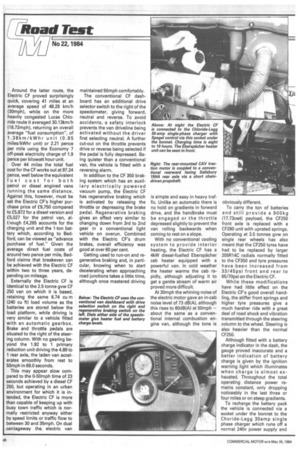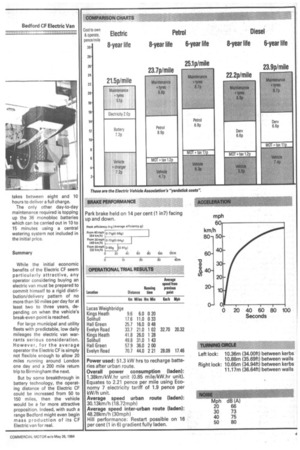'Read Test No 22, 1984
Page 66

Page 67

If you've noticed an error in this article please click here to report it so we can fix it.
Around the latter route, the Electric CF proved surprisingly quick, covering 41 miles at an average speed of 48.28 km/h (30mph), while on the more heavily congested Lucas Chloride route it averaged 30.13km/h (18.72mph), returning an overall average "fuel consumption", of 1.38 km/kWhr unit (0.85 miles/kWhr unit) or 2.21 pence per mile using the Economy 7 off-peak electricity charge of 1.9 pence per kilowatt hour unit.
Over 44 miles the total fuel cost for the CF works out at 97.24 pence, well below the equivalent fuel cost for both petrol or diesel engined vans running the same distance. Against this, however, must be set the Electric CF's higher purchase price of £9,750 compared to £5,872 for a diesel version and £5,027 for the petrol van, although £4,265 accounts for the charging unit and the 1-ton battery which, according to Bedford, can be viewed as "advance purchase of fuel." Given the average direct fuel costs of around two pence per mile, Bedford claims that breakeven can be achieved with the Electric CF within two to three years, depending on mileage.
Externally the Electric CF is identical to the 2.5 tonne gvw CF 250 van on which it is based, retaining the same 6.74 cu m (240 cu ft) load volume as the batteries are stored below the load platform, while driving is very similar to a vehicle fitted with an automatic gearbox. Brake and throttle pedals are situated to the right of the steering column. With no gearing beyond the 1.92 to 1 primary reduction unit driving the 4.89 to 1 rear axle, the laden van accelerates smoothly from rest to 50mph in 69.0 seconds.
This may appear slow compared to the 0-50mph time of 23 seconds achieved by a diesel CF 250, but operating in an urban environment for which it is intended, the Electric CF is more than capable of keeping up with busy town traffic which is normally restricted anyway either. by speed limits or traffic flow to between 30 and 35mph. On dual carriageway the electric van maintained 50mph comfortably.
The conventional CF dashboard has an additional drive selector switch to the right of the speedometer, giving forward, neutral and reverse. To avoid accidents, a safety interlock prevents the van driveline being activated without the driver first selecting neutral. A further cut-out on the throttle prevents drive or reverse being selected if the pedal is fully depressed. Being quieter than a conventional van, the vehicle is fitted with a reversing alarm.
In addition to the CF 350 braking system which has an auxiliary electrically powered vacuum pump, the Electric CF has regenerative braking which is activated by releasing the throttle or depressing the brake pedal. Regenerative braking gives an effect very similar to changing down from 3rd to 2nd gear in a conventional light vehicle on overun. Combined with the Electric CF's drum brakes, overall efficiency was good at over 60 per cent.
Getting used to run-on and regenerative braking and, in particular, knowing when to start decelerating when approaching road junctions takes a little time, although once mastered driving is simple and easy in heavy traffic. Unlike an automatic there is no hold on gradients in forward drive, and the handbrake must be engaged or the throttle depressed slightly to prevent the van rolling backwards when coming to rest on a slope.
With no conventional cooling system to provide interior heating, the Electric CF has a 4kW diesel-fuelled Eberspacher cab heater equipped with a powerful van. In cold weather the heater warms the cab rapidly, although adjusting it to get a gentle stream of warm air proved more difficult.
At 30mph the whining noise of the electric motor gave an in-cab noise level of 73 dB(A), although this rises to 80dB(A) at 50mph — about the same as a conventional internal combustion engine van, although the tone is obviously different.
To carry the ton of batteries and still provide a 900kg (17.73cwt) payload, the CF250 front axle is replaced with a CF280 unit with uprated springs. Operating at 3.5 tonnes gvw on single rear wheels has also meant that the CF250 tyres have had to be replaced by larger 205R14C radials normally fitted to the CF350 and tyre pressures have been increased from 33/45psi front and rear to 65/70psi on the Electric CF.
While these modifications have had little effect on the Electric CF's good overall handling, the stiffer front springs and higher tyre pressures give a much harsher ride with a great deal of road shock and vibration transmitted through the steering column to the wheel. Steering is also heavier than the normal CF250.
Although fitted with a battery charge indicator in the dash, the gauge proved inaccurate and a better indication of battery charge is given by the ignition warning light which illuminates when charge is almost exhausted. Throughout the total operating distance power remains constant, only dropping noticeably in the last three or four miles or on steep gradients.
To recharge the battery pack the vehicle is connected via a socket under the bonnet to the Choride-Legg 30amp single phase charger which runs off a normal 240v power supply and takes between eight and 10 hours to deliver a full charge. The only other day-to-day maintenance required is topping up the 36 monobloc batteries which can be carried out in 10 to 15 minutes using a central watering system not included in the initial price.
Summary While the initial economic benefits of the Electric CF seem particularly attractive, any operator considering buying an electric van must be prepared to commit himself to a rigid distribution/delivery pattern of no more than 50 miles per day for at least two to three years, depending on when the vehicle's break-even point is reached.
For large municipal and utility fleets with predictable, low daily mileages the electric van warrants serious consideration. However, for the average operator the Eiectric CF is simply not flexible enough to allow 20 miles running around London one clay and a 200 mile return trip to Birmingham the next.
But by some breakthrough in battery technology, the operating distance of the Electric CF could be increased from 50 to 150 miles, then the vehicle would be a far more attractive proposition. Indeed, with such a range Bedford might even begin mass production of its CF Electric van for real.








































































































